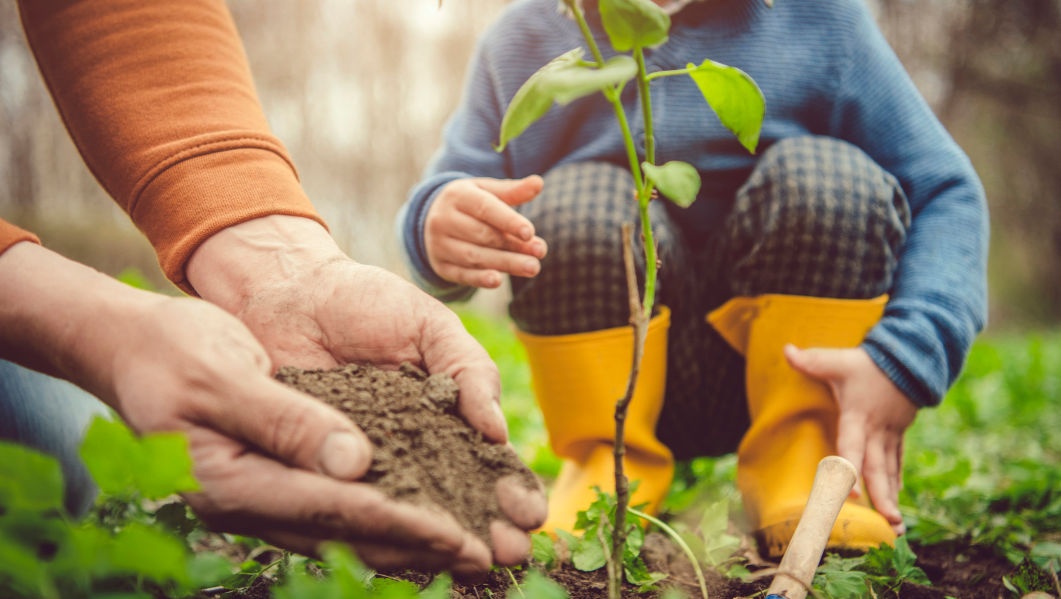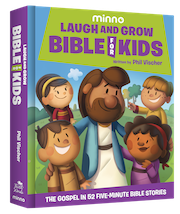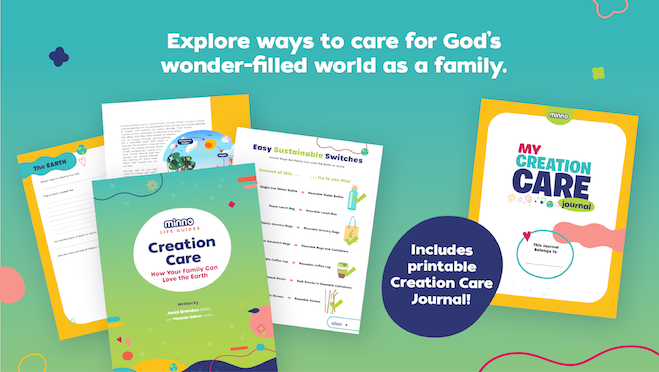Creation Care for Kids: How to Nurture the Earth’s Vegetation

When we think of the terms “creation” and “nature”, most of us probably first think of green plants of some kind. Whether they are lush tropical plants in a dense rainforest, or wildflowers in a beautiful meadow, or towering redwood trees in a shady grove, most of our impressions of nature in its most beautiful, awe-inspiring moments have something to do with vegetation. And that is no accident; God created vegetation, plants, and delicious fruit on the third day, before He even made the stars! (Genesis 1:11-15). Plants are a gift to us from God, as food (Genesis 1:29) and as the way to clean our air of carbon dioxide and give us fresh oxygen. We are made to live in harmony with plants, tending to them in the seasons of planting and harvesting them in the seasons of harvest (Genesis 8:22; Ecclesiastes 3:2).
But plants aren’t just in the Bible as physical objects for food (Genesis 1:29; Mark 11:12-14) or shade (Genesis 18:1); they are also one of Jesus’ favorite illustrations in parables and metaphors. Jesus discusses how if you have faith as small as a mustard seed (only 1-2 millimeters, and the smallest seed known to man in Biblical times), you can move mountains (Matthew 17:20). He talks about faith and mustard seeds again, saying that they are the smallest seeds, but can grow “larger than all of the garden plants and become a tree, so that the birds of the air come and make nests in its branches” (Matthew 13:31-32). He describes Himself as a vine, and us as the branches (John 15:1-11), and many times discusses farmers sowing seeds (Matthew 13:18-30). He talks about the lilies of the field (Matthew 6:28-31), reminding us how He takes care of the plants of creation and will take care of us too.
Clearly Jesus cared deeply for the plants of creation, but He also used them in His parables because people of Biblical times were familiar with what He was saying. They sowed the fields, they labored in the vineyards (Matthew 20:1-6); when Jesus said that a tree would be known by the health of its fruit (Luke 6:43-44) and that a branch that did not bear fruit must be pruned to bear more fruit (John 15:2), He was speaking to an audience that tended fields and vines daily, not to an audience that got their produce in a grocery store. Perhaps part of why we have done a poor job at caring for God’s beautiful nature is that so many of us are so far removed from it. Could we recognize a thistle versus a fig tree? Probably not, and that might be part of the reason why we haven’t cared for God’s creation well.
Important Facts and Statistics About the Earth’s Vegetation
Since 1990, it is estimated that 1.04 billion acres of forest have been lost worldwide, due to conversion to other land uses (Source: United Nations). In the tropics, rainforests are most often turned into cattle ranches and agricultural land, as we become further and further detached from the original intent for that beautiful land. Today, tropical rainforests cover only 6% of the world’s land surface, less than half of what they used to cover. Even so, tropical rainforests hold about 80% of the world’s documented terrestrial plants and animal species, although new species are being discovered all the time (WWF). The Amazon Rainforest alone produces 20% of the world’s oxygen, through its dense canopy of trees and rich biodiversity of plants (Source: National Geographic). These plants, in tropical rainforests, snowy evergreen forests, and everywhere in between need to be protected. Scientists have identified approximately 60,000 species of trees, of which a third are on the IUCN List of Threatened Species, and 1,400 are Critically Endangered (Source: IUCN, United Nations).
These trees are responsible for our food, for the wood carpenters like Jesus use to make our homes and furniture, and for the very air we breathe. But they can only keep up with our demand if they have time to regrow a new supply. We are cutting trees down too fast without replanting them, turning forests into ranchland and cityscapes, and redirecting the water needed to grow our crops. What can be done about it? Well, a lot actually. The beautiful thing about nature, is that it can grow back. But we have to help it get there!

How can we steward the vegetation and nature around us?
- Get out in nature! Has it been a while since your family stood in a grove of really tall trees and felt that amazing, small feeling of being surrounded by big, big nature? Get out and do it! Whether it’s a socially distanced hike or a safe camping trip, get out in the great outdoors, and remind yourself and your kids why nature is such an amazing gift from God, and why it is worth protecting in the first place.
- Watch a seed sprout and grow. As Jesus says in Matthew 13, it’s truly remarkable that an entire plant or tree comes out of a teeny tiny seed. Plant some seeds with your little ones and let them watch the magic of nature unfold in front of their very eyes.
- Look for the Rainforest Alliance seal on products at the grocery store. The Rainforest Alliance seal indicates that those products are helping conserve forests, build climate resilience, and are improving the communities that live in the forests where these products are grown. It’s a great way to know that our products are not only not adding to deforestation, but are actually helping stop it!
- Start a compost bin. If you want to take your love of nature further, you can start a compost bin or worm bin to compost all of your plant waste (like banana peels, coffee grounds, and carrot tops). Instead of going to the landfill, where they pile up on land and add to greenhouse gas emissions, they will naturally break down into soil compost that you can then use in your garden. When I started a worm bin, I was shocked at how much of my weekly garbage was compostable!
- Buy organic and local fruits and vegetables. Buying organic means that you are buying produce that is not covered in harmful pesticides, and is not adding those harmful pesticides to the earth or to your body. Buying local means you are supporting local farmers and buying produce that is not shipping around the world, which can equal lots of carbon emissions.
. . . . . . . . . .
Next Post in the Series: How to Love Living Creatures, Great and Small
. . . . . . . . . .
Caring for God’s amazing creation can feel like a really big job! But you don’t have to memorize statistics, understand the latest science, or even dramatically change your lifestyle to care for the earth. Creation care can start with simple habits and just being aware . . . that God created the earth and every amazing thing in it, and that we are called to take care of His creation.
Our latest Minno Life Guide: Creation Care: How Your Family Can Love the Earth, written by Jenni Brandon, Ph.D. and Senior Scientist at Applied Ocean Sciences, will help your family discover small changes that will make a big impact on the beautiful world God made.
- Learn scientific facts about our land, air, water, plants, and animals and how they are changing for the good and not-so-good.
- Discover ways your family can make small changes to help conserve our resources.
- Engage in conversations and simple creation care practices with the ideas and prompts in this guide.
- Use the included Creation Care Journal to guide kids on a journey of exploration into the wonderful world God made and their opportunity to steward it well.
Visit the Minno Store to get your Creation Care Life Guide!
. . . . . . . . . .

Jenni Brandon received her Ph.D. in Biological Oceanography at Scripps Institution of Oceanography in December 2017, focusing on the nascent field of marine microplastics. She is an expert in quantifying and identifying marine microplastics and has developed multiple novel methods to identify the spatial and temporal ranges of microplastics and determine the age of plastics exposed to varying weathering conditions in the environment. She is passionate about the world of science communication, having given hundreds of interviews and talks to all types of stakeholders, and was a college lecturer on communicating science to the public during her post-doc at Birch Aquarium. She is active in her church and serves as a Young Life committee member in Encinitas, California. For more of her personal outreach articles and articles about her research, please check out www.jenniferabrandon.com or follow her on twitter at @PlasticsJenni.
. . . . . . . . . .
Minno Shows About Creation
The Wonderful World of Science with Dr. Schniffenhousen
Minno Books about Creation

Board Books featuring beloved What’s In The Bible? brothers, Clive and Ian:

